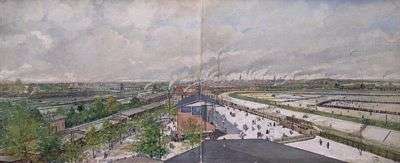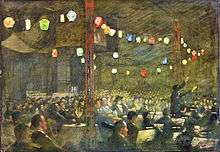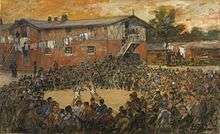Ruhleben internment camp

_(14775299891).jpg)
Ruhleben internment camp was a civilian detention camp in Germany during World War I. It was located in Ruhleben, a former Vorwerk manor 10 km (6.2 mi) to the west of Berlin, now split between the districts of Spandau and Charlottenburg-Wilmersdorf. The camp was originally a harness racing track laid out north of the Berlin-Hamburg Railway line in 1908.
Detainees

The camp detainees included male citizens of the Allied Powers living, studying, working or on holiday in Germany at the outbreak of World War I. They also included the crews of several civilian ships stranded in German harbours or captured at sea. There were in addition a number of fishermen captured from trawlers which were sunk in the North Sea in the first days of the war: these were mainly men from Hull, Grimsby and Boston. The camp varied between 4,000 and 5,500 prisoners, most of them British. Life in the camp was described in several books and essays subsequently written by detainees. These included To Ruhleben – And Back (1916) by Geoffrey Pyke,[1] who had successfully escaped from the camp in 1915, and Life in Ruhleben, 1914–1918 (1920) by Frederick Keel.[2] Quarters were cramped; the stable blocks averaged 27 stalls each housing six men; the stable block lofts each housed about 200 men.[3]
The German authorities adhered to the Geneva Convention and allowed the camp detainees to administer their own internal affairs. Gradually, a mini-society evolved in the camp. Letters, books, sports equipment and a printing press were all allowed into the camp and the detainees organised their own police force, magazine, library and postal service. The latter, known as the Ruhleben Express Delivery, was organised by Albert Kamps and began operating in July 1915. Soon it was handling over 6,000 pieces of mail per month and 16 different postage stamps, which have since become collectors items, were issued. In April 1916 however the German postal authorities declared the service illegal and it ceased operating. In addition, a number of independent businesses, including a casino, also developed within the camp.
Arts and culture

The detainees arranged their own entertainment. Among them were several musicians, including Ernest MacMillan, later to become a conductor of the Toronto Symphony Orchestra. Other British musicians included Edgar Bainton,[4] Edward Clark and the Australian-born Arthur Benjamin.[5][6] MacMillan was a prominent member of the Ruhleben Musical Society, formed in 1915, and directed performances of The Mikado (with orchestra and costumes) and a pantomime version of Cinderella. MacMillan transcribed the music for the former from memory with the help of four other musicians, including Benjamin Dale.[7] Among those who attended these performances were James W. Gerard, the United States ambassador. The detainees also presented Trial by Jury, The Pirates of Penzance, The Yeomen of the Guard and The Gondoliers.[7][8] MacMillan gave lectures on each of Beethoven's symphonies, which were followed by piano duet performances played by him together with Benjamin Dale.[9] MacMillan was also a member of the Ruhleben Drama Society and acted in productions of Othello, Twelfth Night, Lady Windermere's Fan and The Importance of Being Earnest.[10]
Sports

Sports also played a major role in the lives of the detainees. Among them were several former professional footballers, including four former England internationals, Fred Spiksley, Fred Pentland, Samuel Wolstenholme and Steve Bloomer; a Scotland international, John Cameron; a German international, Edwin Dutton; and John Brearley, once of Everton and Tottenham Hotspur. The Ruhleben Football Association was formed with Pentland as chairman and Cameron as secretary. Cup and league competitions were organised and teams adopted the names of established teams such as Tottenham Hotspur and Oldham Athletic. As many as 1,000 attended the bigger games. On 2 May 1915 an "England XI" featuring Pentland, Wolstenholme, Brearley and Bloomer played a "World XI" captained by Cameron. Towards the end of the war an international triangular tournament called the Coupe de Allies, featuring a "British XI", a "French XI" and a "Belgium XI", was organised. Other sports such as cricket, rugby, tennis and golf were also popular within the camp. In May 1915 a "Ruhleben XI", featuring Bloomer and Brearley, played a "Varsities XI" in the Ruhleben Cricket League. In July 1916 a "Lancashire XI", featuring Bloomer, beat a "Yorkshire XI" that included Wolstenholme.
Notable detainees
- F. Charles Adler
- Edgar Bainton
- John Balfour
- Winthrop Pickard Bell
- Arthur Benjamin
- Steve Bloomer
- Roland Bocquet
- John Brearley
- Henry Brose
- John Cameron
- Sir James Chadwick
- Edward Clark
- Israel Cohen
- Benjamin Dale
- Sefton Delmer
- Dr Arthur Henry Douthwaite
- William Huntley Drummond, 6th Earl of Perth
- Edwin Dutton
- Harry Edward
- Sir Charles D. Ellis
Maurice Leon Ettinghausen
- Charles Fryatt
- Percy Hartley
- Percy Hull
- Nico Jungmann
- Frederick Keel
- Peter Carl Mackay, alias Prince Monolulu
- Ernest MacMillan
- Thomas Humphrey Marshall
- John Cecil Masterman
- George Merritt
- Michael Pease
- Fred Pentland
- Geoffrey Pyke
- R. M. Smyllie
- Fred Spiksley
- Jascha Spivakovsky
- Tom Sullivan
- Samuel Wolstenholme
See also
| Wikimedia Commons has media related to Ruhleben internment camp. |
References
Notes
- ↑ Pyke, 1916.
- ↑ Keel, 1920.
- ↑ Evans, Stephen (28 July 2014). "The prisoners of war who made Little Britain in Berlin". BBC News. Retrieved 30 July 2014.
- ↑ Joseph W Pegg, Newcastle's Musical Heritage: An Introduction
- ↑ LindaJo K. McKim, LindaJo H. McKim, The Presbyterian Hymnal Companion
- ↑ Joseph W. Lewis, What Killed the Great and Not So Great Composers?
- 1 2 MacMillan, Sir Ernest (1997). MacMillan on music: essays on music, Carl Morey (ed.) pp. 25–29, Dundurn Press ISBN 1-55002-2857
- ↑ Photo of the prisoners in The Gondoliers, 1917, accessed 30 May 2012
- ↑ Nevins, Maureen (1994). Sir Ernest MacMillan: portrait of a Canadian musician (1893–1973), Ruhleben. Library and Archives Canada (electronic collection). Retrieved 2011-09-12.
- ↑ Hart, Harold B. (9 January 1918). "Life in Ruhleben – Stories of Returned Civil Prisoners". The Scotsman. pp. 5, 11.
Bibliography
- Cimino, Hugh (1915). Behind the Prison Bars in Germany: A Detailed Record of Six Months' Experiences in German Prisons and Detention Camps, by a British Doctor. Newnes.
- Cohen, Israel (1917). The Ruhleben Prison Camp: a record of nineteen months' internment. London: Methuen.
- Foreman, Lewis (2011). "In Ruhleben camp". First World War Studies. 2 (1): 27–40.
- Keel, Frederick (1920). "Life in Ruhleben, 1914–1918". In Williamson, George Charles. Ye Second Volume of ye Roll of ye Members of ye Sette of Odd Volumes. 72. London: Sette of Odd Volumes. pp. 87–110.
- Ketchum, J. Davidson (1965). Ruhleben: a prison camp society. Toronto: University of Toronto Press.
- Powell, Joseph; Gribble, Francis (1919). The History of Ruhleben: a record of British organisation in a prison camp in Germany. London: Collins. Retrieved 30 July 2014.
- Pyke, Geoffrey (1916). To Ruhleben – and Back: A Great Adventure in Three Phases. London: Constable.
- Stibbe, Matthew (2008). British Civilian Internees in Germany: the Ruhleben camp, 1914–18. Manchester: Manchester University Press. ISBN 9780719070846.
- Wyke, Terry (2013). "Walter Butterworth: a 'Manchester man' in a German prison camp". Transactions of the Lancashire and Cheshire Antiquarian Society. 109: 145–65.
Further reading
Heidi König, General relativity in the English-speaking world: the contributions of Henry L. Brose.In Historical Records of Australian Science, v.17, no.2, Dec 2006, p.169-195 (ISSN: 0727-3061) (contains a chapter on Brose's memories of Ruhleben)
External links
- Maurice Ettinghausen Collection of Ruhleben Civilian Internment Camp Papers, 1914-1937 at Harvard Law School Library
- John Masterman Collection of Ruhleben Civilian Internment Camp Papers, 1914-1937 at Harvard Law School Library
- Ruhleben Internment Camp - A British community in war-time Germany
- 1936 Summer Olympics official report. Volume 2. pp. 827–36.
- The Ruhleben Story.
- Ruhleben P.O.W. Camp Stamps
- Sir Ernest MacMillan at Ruhleben
- Ruhleben at National Library of Scotland
- The prisoners of war who grew 33,000 lettuces BBC News Magazine 29 July 2014
- The prisoners of Ruhleben BBC 24 August 2014
